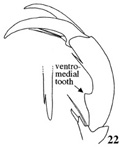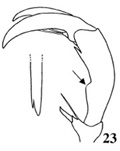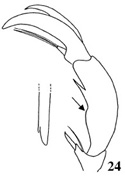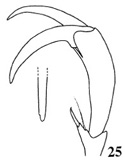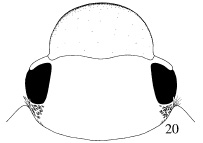
| 1. Larger protarsal claw appearing simple (claw of male with or without
weak, apical nib in frontal view [Fig. 25, inset]; claw of female simple
[Fig. 27]). Tarsomere 5 without ventromedial tooth (Fig. 25) ............ B. germaini (Ohaus) 1'. Larger protarsal claw split or toothed (claw of male split at apex in frontal view [Figs. 22–24]; claw of female toothed in dorsal view [Fig. 26]). Tarsomere 5 with ventromedial tooth (Fig. 22–24, 26) ..................................................... 2
|
||||||||||||||
| 2. Margin of elytron in ventral view with epipleuron expanded (Fig. 14) ........................................................................... B. marginatus Germain 2'. Margin of elytron in ventral view with epipleuron not expanded (Fig. 15) .............................................................................................................. 3
|
||||||||||||||
| 3. Metatibia with inner and outer edges bowed, widest at middle (male; Fig. 19) or with inner edge bowed (female). Clypeus with weak basal constriction (Fig. 21). Elytral margin with dense, long, hair-like setae (Fig. 11c) ..................................................... B. patagoniensis Jameson and Smith 3'. Metatibia with inner edge straight, not bowed, widest at apex (e.g., Figs. 16–18). Clypeus without basal constriction (e.g., Fig. 20). Elytral margin with short or moderately long, thickened or scale-like setae (Fig. 11a, b) ............... 4
|
||||||||||||||
| 4. Pygidium at basolateral margins with thickened or scale-like setae (Fig.
11a–b). Apex of terminal sternite in female deeply emarginate (Fig. 12).
Antennal club subequal in length to segments 1–7 (male and female) ................................ 5 4'. Pygidium at basolateral margins with thickened and hair-like setae (Fig. 11b–c), lacking scale-like setae. Apex of terminal sternite in female moderately emarginate (Fig. 13). Antennal club slightly longer than segments 1–7 (male) ........................................................ B. olivaceus (Philippi and Philippi)
|
||||||||||||||
| 5. Sternites densely clothed with scale-like setae (sometimes only along lateral edges) (Fig. 11a). Elytron with apical umbone well developed ............................................................ B. angustus (Philippi and Philippi) 5'. Sternites with moderately dense, thickened setae (Fig. 11b). Elytron with apical umbone poorly developed ............................................................. 6
|
||||||||||||||
| 6. Region posterior to eye with scale-like setae (Figs. 11a, 20). Clypeus of male and female tan or castaneous. Meso- and metafemora and meso- and metatibia testaceous with green sheen ............. B. prasinus Guérin-Méneville 6'. Region posterior to eye with thickened setae (Fig. 11b). Clypeus of female castaneous; clypeus of male green. Meso- and metafemora and meso- and metatibia testaceous, lacking green sheen (sometimes with weak greenish reflections) .......................................................... B. spectabilis Erichson
|
||||||||||||||
Authors:Mary Liz Jameson (University of Nebraska State Museum) and |
